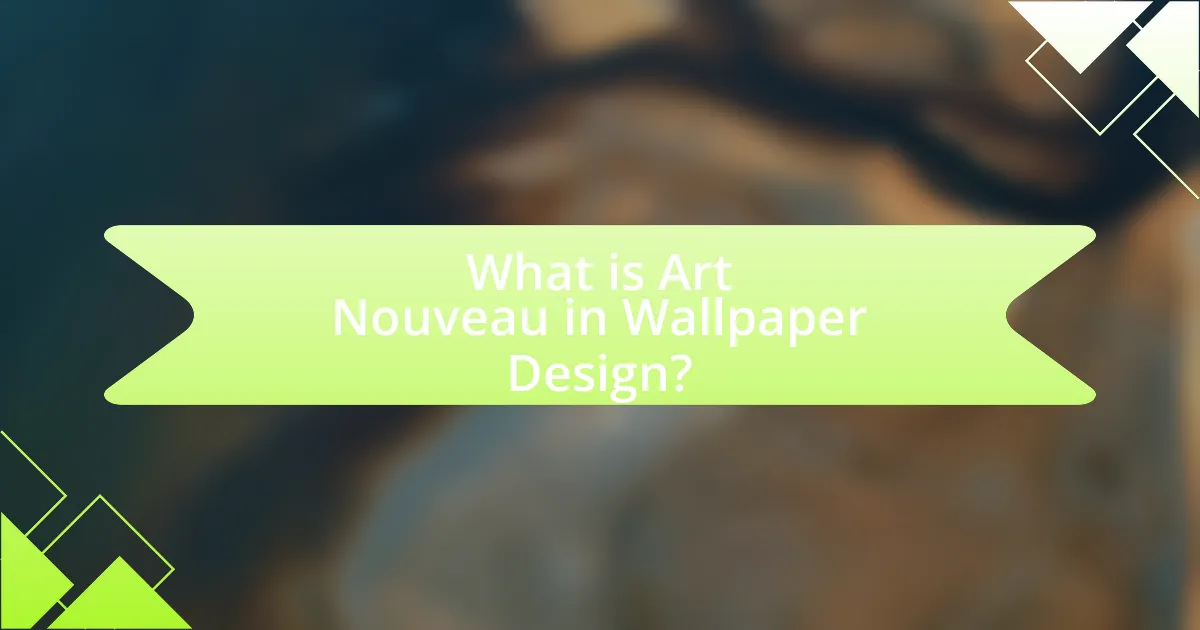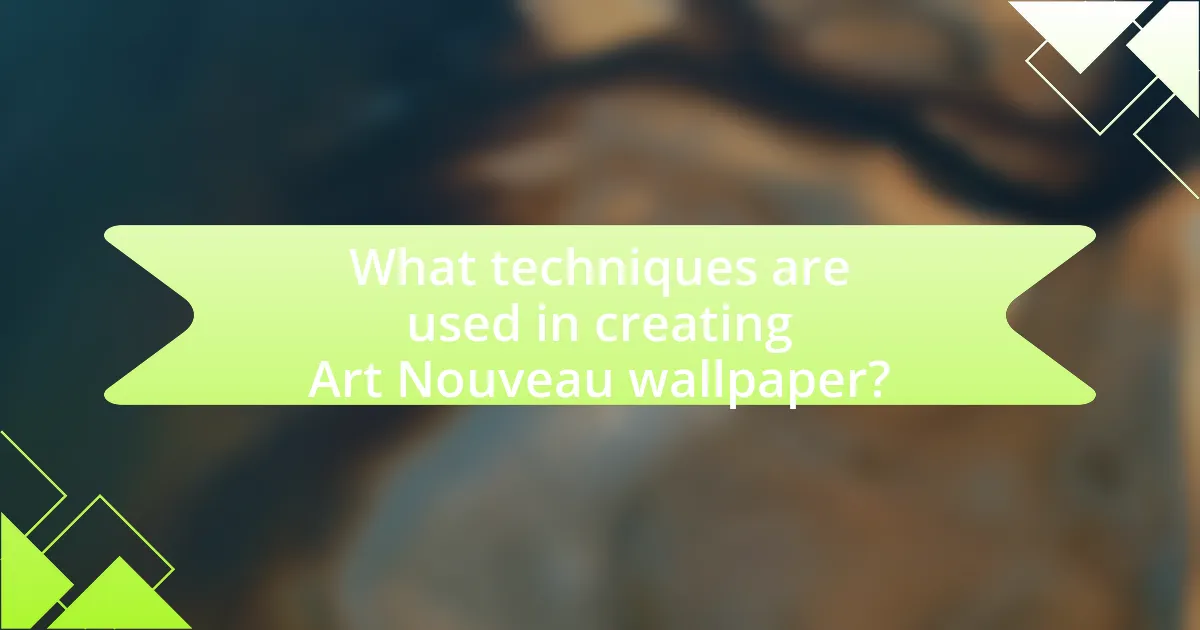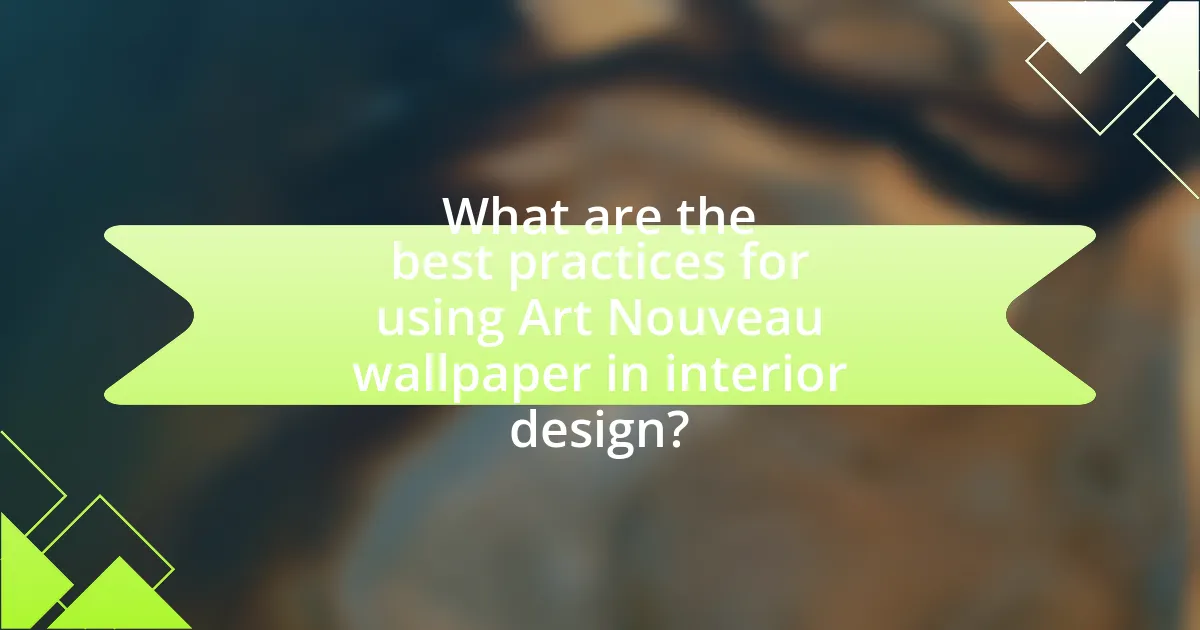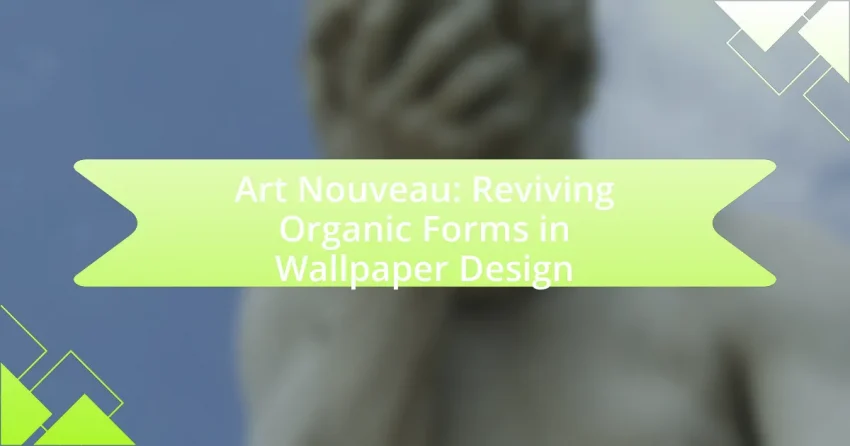Art Nouveau is a decorative style in wallpaper design that emerged in the late 19th century, characterized by organic forms, flowing lines, and intricate patterns inspired by nature. This movement sought to break away from traditional artistic conventions, emphasizing harmony between art and the natural world, with notable designers like Alphonse Mucha and Gustav Klimt leading the way. The article explores the historical influences that shaped Art Nouveau, its key characteristics, and its significance in wallpaper design, as well as its impact on modern trends and interior design practices. Additionally, it discusses the techniques used in creating Art Nouveau wallpaper, best practices for incorporating it into interiors, and maintenance tips for preserving its integrity.

What is Art Nouveau in Wallpaper Design?
Art Nouveau in wallpaper design is a decorative style characterized by its use of organic forms, flowing lines, and intricate patterns inspired by nature. This movement emerged in the late 19th century and sought to break away from traditional artistic conventions, emphasizing harmony between art and the natural world. Notably, designers like Alphonse Mucha and Gustav Klimt incorporated floral motifs and curvilinear shapes into their wallpaper designs, reflecting the broader Art Nouveau philosophy of integrating beauty into everyday life. The style is recognized for its innovative use of color and texture, which contributed to the revival of decorative arts during this period.
How did Art Nouveau emerge as a design movement?
Art Nouveau emerged as a design movement in the late 19th century as a reaction against academic art and industrialization. This movement sought to create a new aesthetic that emphasized organic forms, flowing lines, and the integration of art into everyday life. The 1890 Paris Exposition Universelle showcased Art Nouveau’s principles, highlighting the works of artists like Alphonse Mucha and architects such as Hector Guimard, who incorporated natural motifs into their designs. The movement gained momentum through publications like “L’Art Nouveau” and the establishment of the Vienna Secession, which further promoted the style across Europe.
What historical influences shaped Art Nouveau’s development?
Art Nouveau’s development was shaped by a combination of the Industrial Revolution, the Arts and Crafts Movement, and Japanese art influences. The Industrial Revolution introduced new materials and production techniques, allowing for innovative designs and mass production. The Arts and Crafts Movement, which emphasized handcrafted quality and a return to nature, inspired Art Nouveau’s organic forms and decorative motifs. Additionally, the influx of Japanese art in the late 19th century, characterized by its emphasis on nature and asymmetry, significantly influenced the aesthetic principles of Art Nouveau, leading to a unique fusion of styles that celebrated natural forms and intricate designs.
How did Art Nouveau differ from previous design styles?
Art Nouveau differed from previous design styles by emphasizing organic forms, flowing lines, and intricate patterns inspired by nature. Unlike the rigid geometric shapes and historical references prevalent in styles such as Neoclassicism and Victorian design, Art Nouveau embraced a more fluid aesthetic that sought to harmonize art with the natural world. This movement, which flourished from the late 19th century to the early 20th century, was characterized by its use of asymmetry and the incorporation of motifs like flowers, plants, and other natural elements, setting it apart from its predecessors. The focus on craftsmanship and the integration of decorative arts into everyday objects further distinguished Art Nouveau, making it a pivotal shift in design philosophy.
What are the key characteristics of Art Nouveau wallpaper design?
Art Nouveau wallpaper design is characterized by its organic forms, flowing lines, and intricate patterns. This style emphasizes natural motifs, such as flowers, plants, and curvilinear shapes, which reflect the movement’s inspiration from nature. The use of vibrant colors and decorative elements, often with a sense of harmony and unity, further defines Art Nouveau wallpaper. Additionally, the incorporation of asymmetry and a focus on craftsmanship highlight the artistic intent behind the designs, making them distinct from previous styles.
How do organic forms manifest in Art Nouveau wallpaper?
Organic forms manifest in Art Nouveau wallpaper through the incorporation of flowing lines, natural motifs, and asymmetrical designs that mimic the shapes found in nature. This style emphasizes elements such as flowers, leaves, and vines, which are often stylized and intertwined, creating a sense of movement and fluidity. The use of these organic forms reflects the broader Art Nouveau movement’s goal of harmonizing art with nature, as seen in the works of prominent designers like Alphonse Mucha and William Morris, who utilized intricate patterns and organic shapes to evoke the beauty of the natural world.
What color palettes are commonly used in Art Nouveau wallpaper?
Art Nouveau wallpaper commonly features color palettes that include muted earth tones, soft pastels, and rich jewel tones. These palettes often incorporate colors such as olive green, deep blue, warm amber, and soft pink, reflecting the movement’s emphasis on natural forms and organic motifs. The use of these colors is supported by the historical context of the Art Nouveau movement, which sought to harmonize art with nature, as seen in the works of prominent designers like Alphonse Mucha, who frequently utilized these hues to evoke a sense of elegance and fluidity in his designs.
Why is Art Nouveau significant in the context of wallpaper design?
Art Nouveau is significant in the context of wallpaper design because it introduced a revolutionary aesthetic that emphasized organic forms and intricate patterns. This movement, which flourished from the late 19th to early 20th century, marked a departure from traditional design by incorporating flowing lines, floral motifs, and natural elements, reflecting a harmony between art and nature. Notably, designers like Alphonse Mucha and Gustav Klimt created wallpapers that showcased these characteristics, influencing interior design and setting a new standard for decorative arts. The use of innovative printing techniques during this period also allowed for greater detail and color vibrancy, further solidifying Art Nouveau’s impact on wallpaper design.
What cultural impacts did Art Nouveau have on interior design?
Art Nouveau significantly influenced interior design by promoting organic forms and intricate patterns that emphasized harmony with nature. This movement, which emerged in the late 19th century, encouraged the use of flowing lines, floral motifs, and asymmetrical shapes, which contrasted sharply with the rigid styles of previous eras. Notably, designers like Hector Guimard and Antoni Gaudí incorporated these elements into their work, creating spaces that felt more alive and connected to the natural world. The impact of Art Nouveau is evident in the widespread adoption of decorative arts, including furniture, textiles, and wallpaper, which featured elaborate designs inspired by botanical themes. This cultural shift not only transformed aesthetic preferences but also fostered a greater appreciation for craftsmanship and the integration of art into everyday life.
How did Art Nouveau influence modern wallpaper trends?
Art Nouveau significantly influenced modern wallpaper trends by introducing organic forms, intricate patterns, and a focus on nature-inspired designs. This movement, which flourished from the late 19th to early 20th century, emphasized flowing lines and stylized floral motifs, which have become foundational elements in contemporary wallpaper design. The revival of these aesthetic principles is evident in modern wallpapers that often feature botanical illustrations and curvilinear patterns, reflecting the Art Nouveau ethos of harmonizing art with nature. The impact of Art Nouveau is also seen in the use of innovative printing techniques and materials, which have evolved but still draw inspiration from the craftsmanship and artistic vision of that era.
How does Art Nouveau connect to contemporary design practices?
Art Nouveau connects to contemporary design practices through its emphasis on organic forms, intricate patterns, and the integration of art with everyday objects. This movement, which flourished from the late 19th to early 20th century, has influenced modern designers who prioritize fluid lines and natural motifs in their work. For instance, contemporary wallpaper designs often draw inspiration from the sinuous shapes and botanical themes characteristic of Art Nouveau, reflecting a continued appreciation for nature in design. Additionally, the movement’s holistic approach, which seeks to harmonize aesthetics with functionality, resonates with current trends in sustainable and user-centered design practices.
What are the challenges of incorporating Art Nouveau in modern wallpaper design?
Incorporating Art Nouveau in modern wallpaper design presents challenges such as balancing intricate organic patterns with contemporary aesthetics and ensuring production feasibility. The complexity of Art Nouveau’s flowing lines and natural motifs can clash with minimalist design trends prevalent today, making it difficult to appeal to a broader audience. Additionally, the production of high-quality prints that accurately reflect the detailed craftsmanship of Art Nouveau requires advanced printing technology and materials, which can increase costs and limit accessibility. Historical context shows that Art Nouveau was characterized by its emphasis on craftsmanship and artistic expression, which may not align with the mass-production methods commonly used in modern wallpaper manufacturing.

What techniques are used in creating Art Nouveau wallpaper?
Art Nouveau wallpaper is created using techniques such as lithography, block printing, and screen printing. Lithography involves drawing designs on a flat stone or metal plate, allowing for intricate patterns and vibrant colors, which were characteristic of the Art Nouveau style. Block printing uses carved wooden or linoleum blocks to transfer designs onto paper, enabling the reproduction of organic forms and flowing lines typical of the movement. Screen printing, or serigraphy, employs a mesh screen to apply ink, allowing for detailed and layered designs that reflect the natural motifs prevalent in Art Nouveau. These techniques collectively contribute to the unique aesthetic of Art Nouveau wallpaper, emphasizing the revival of organic forms and intricate designs.
How are patterns and motifs developed in Art Nouveau wallpaper?
Patterns and motifs in Art Nouveau wallpaper are developed through the integration of organic forms, flowing lines, and natural elements. Designers such as Alphonse Mucha and Gustav Klimt emphasized the use of sinuous curves and stylized floral and plant motifs, reflecting the movement’s focus on nature and beauty. The aesthetic is characterized by intricate designs that often feature asymmetry and a harmonious color palette, which enhances the organic feel. Historical context shows that Art Nouveau emerged in the late 19th century as a reaction against industrialization, aiming to create art that was both functional and decorative, thus reinforcing the connection between the patterns and the natural world.
What role do natural forms play in the design process?
Natural forms serve as a fundamental inspiration in the design process, particularly in the Art Nouveau movement, which emphasizes organic shapes and motifs. Designers utilize natural forms to create visually harmonious and fluid designs that reflect the beauty of nature. This approach not only enhances aesthetic appeal but also fosters a connection between the artwork and the natural environment. Historical examples include the use of floral patterns and curvilinear lines in wallpaper designs, which were prevalent in Art Nouveau, showcasing how these elements can transform interior spaces into serene and organic environments.
How is color theory applied in Art Nouveau wallpaper creation?
Color theory is applied in Art Nouveau wallpaper creation through the use of harmonious color palettes that evoke natural forms and emotions. Designers often utilized complementary and analogous color schemes to create depth and visual interest, reflecting the movement’s emphasis on organic shapes and flowing lines. For instance, the use of muted earth tones alongside vibrant floral hues not only enhances the aesthetic appeal but also aligns with the Art Nouveau philosophy of integrating art with nature. Historical examples include the works of artists like Alphonse Mucha, who employed color gradients to mimic the softness of natural light, reinforcing the connection between color and the organic motifs prevalent in the designs.
What printing methods are commonly used for Art Nouveau wallpaper?
Commonly used printing methods for Art Nouveau wallpaper include lithography, block printing, and screen printing. Lithography, developed in the late 18th century, allows for detailed and colorful designs, making it ideal for the intricate patterns characteristic of Art Nouveau. Block printing, a traditional method where designs are carved into wood or linoleum, was also popular during this period, enabling artisans to create unique, hand-crafted wallpapers. Screen printing, which became more prevalent in the 20th century, offers versatility and the ability to produce bold colors and complex designs, aligning well with the organic forms celebrated in Art Nouveau aesthetics.
How does lithography contribute to the production of Art Nouveau designs?
Lithography significantly contributes to the production of Art Nouveau designs by enabling the mass reproduction of intricate and organic motifs characteristic of the style. This printing technique allows artists to create detailed images with fluid lines and vibrant colors, which are essential elements of Art Nouveau aesthetics. Historical evidence shows that lithography was widely adopted by artists such as Alphonse Mucha, who utilized it to produce posters and decorative art that embodied the movement’s emphasis on nature and elegance. The ability to replicate designs efficiently made lithography a crucial tool for disseminating Art Nouveau art to a broader audience, thus solidifying its impact on wallpaper design and other decorative arts during the late 19th and early 20th centuries.
What advancements in technology have influenced Art Nouveau wallpaper printing?
Advancements in technology that have influenced Art Nouveau wallpaper printing include the development of lithography and advances in color printing techniques. Lithography, invented in the late 18th century, allowed for more intricate designs and the reproduction of detailed illustrations, which were essential for the organic forms characteristic of Art Nouveau. Additionally, the introduction of chromolithography in the 19th century enabled printers to produce vibrant colors and complex patterns, enhancing the aesthetic appeal of wallpaper. These technologies facilitated the mass production of wallpaper, making Art Nouveau designs widely accessible and popular during the movement’s peak in the late 19th and early 20th centuries.

What are the best practices for using Art Nouveau wallpaper in interior design?
The best practices for using Art Nouveau wallpaper in interior design include selecting designs that emphasize organic forms and flowing lines, as these are characteristic of the Art Nouveau style. Incorporating wallpaper in spaces with ample natural light enhances the intricate patterns and colors, allowing the design to come alive. Additionally, pairing Art Nouveau wallpaper with complementary furnishings and decor, such as curved furniture and natural materials, creates a cohesive aesthetic. Historical context shows that Art Nouveau emerged in the late 19th century, focusing on harmony with nature, which can be reflected in the choice of botanical motifs and soft color palettes. Using these principles ensures that the wallpaper enhances the overall design while honoring the artistic movement’s essence.
How can Art Nouveau wallpaper enhance a room’s aesthetic?
Art Nouveau wallpaper enhances a room’s aesthetic by introducing intricate, organic designs that evoke a sense of nature and elegance. The style is characterized by flowing lines, floral motifs, and natural forms, which create a harmonious and visually stimulating environment. Historical context shows that Art Nouveau emerged in the late 19th century as a reaction against industrialization, emphasizing craftsmanship and artistic expression. This wallpaper style can transform a space by adding depth and character, making it feel more inviting and sophisticated. The use of rich colors and detailed patterns in Art Nouveau wallpaper can also influence the mood of a room, promoting relaxation and creativity.
What tips should be considered when selecting Art Nouveau wallpaper?
When selecting Art Nouveau wallpaper, consider the intricate patterns and organic motifs characteristic of the style. Look for designs that feature flowing lines, floral elements, and natural forms, as these are hallmarks of Art Nouveau aesthetics. Additionally, assess the color palette; muted tones and earthy hues are often used to evoke a sense of harmony with nature. Historical context is also important; Art Nouveau emerged in the late 19th century, so authentic reproductions or designs inspired by that era will enhance the overall authenticity of your space. Finally, ensure the wallpaper material is suitable for your environment, as durability and texture can significantly impact the visual effect and longevity of the design.
How can one effectively pair Art Nouveau wallpaper with other design elements?
To effectively pair Art Nouveau wallpaper with other design elements, one should focus on complementary colors and organic shapes that reflect the movement’s emphasis on nature. Art Nouveau is characterized by flowing lines and intricate floral patterns, so selecting furniture and decor that echo these curves enhances the overall aesthetic. For instance, pairing the wallpaper with wooden furniture featuring sinuous designs or wrought iron accents can create a cohesive look. Additionally, incorporating textiles with similar motifs, such as cushions or drapes that showcase botanical prints, reinforces the theme. Historical context supports this approach, as Art Nouveau emerged in the late 19th century, emphasizing harmony between architecture, interior design, and decorative arts, which can be achieved through thoughtful pairing of elements.
What maintenance practices are recommended for preserving Art Nouveau wallpaper?
To preserve Art Nouveau wallpaper, it is recommended to maintain a stable environment with controlled humidity and temperature, ideally between 40-60% humidity and 18-22°C (64-72°F). Regular dusting with a soft, dry cloth prevents dirt accumulation, while avoiding direct sunlight protects the colors and patterns from fading. Additionally, using a gentle, pH-neutral cleaner for spot cleaning can help remove stains without damaging the wallpaper. These practices are essential because Art Nouveau wallpaper often features delicate designs and materials that can deteriorate if not properly cared for.
How can one clean and care for Art Nouveau wallpaper without damage?
To clean and care for Art Nouveau wallpaper without damage, use a soft, dry cloth to gently dust the surface, avoiding any abrasive materials. For stains, lightly dampen the cloth with water or a mild soap solution, ensuring it is not soaking wet, and gently blot the area without scrubbing. Art Nouveau wallpaper often features delicate patterns and materials, making excessive moisture harmful, as it can lead to peeling or discoloration. Historical preservation guidelines recommend this method to maintain the integrity of vintage wallpapers, as excessive cleaning can compromise their condition.
What common issues should be addressed to maintain the integrity of Art Nouveau wallpaper?
To maintain the integrity of Art Nouveau wallpaper, it is essential to address issues such as moisture damage, fading due to light exposure, and physical wear from handling. Moisture can lead to mold growth and deterioration of the paper, while prolonged exposure to sunlight can cause colors to fade, compromising the aesthetic quality of the design. Additionally, physical wear from cleaning or touching can result in scratches or tears, further damaging the wallpaper. Historical preservation practices emphasize the importance of controlling environmental conditions, such as humidity and light levels, to protect these delicate artworks.
